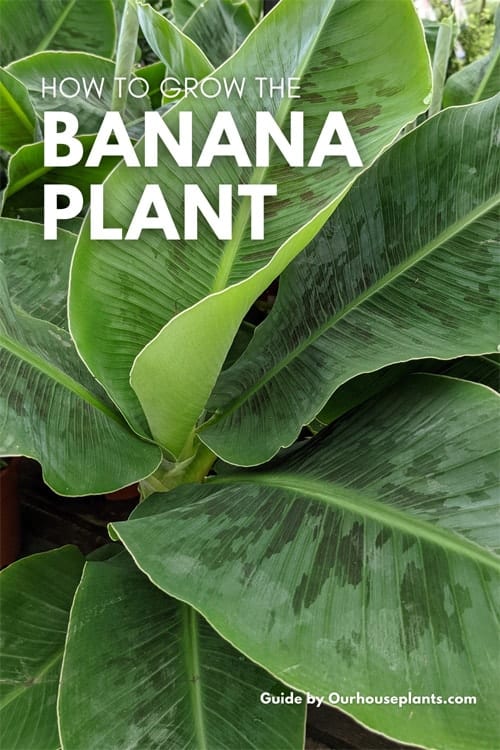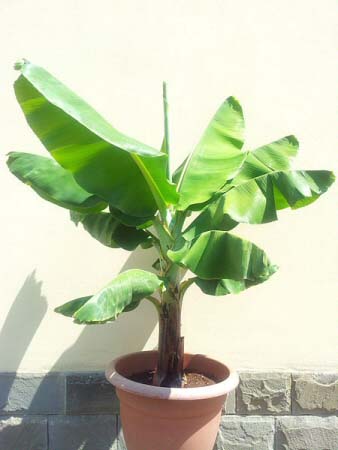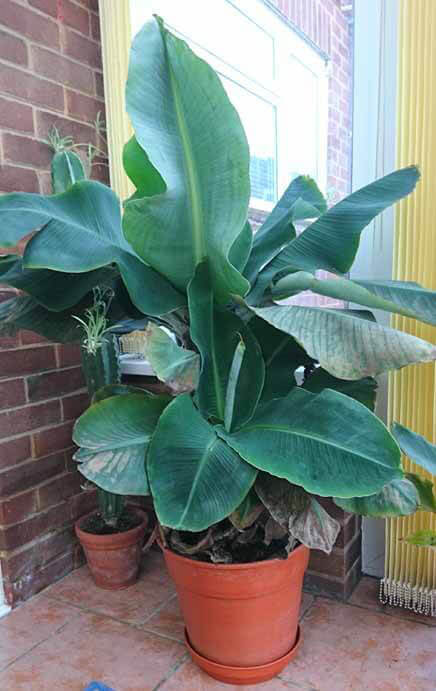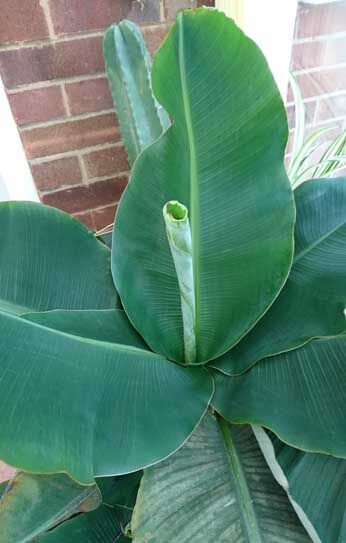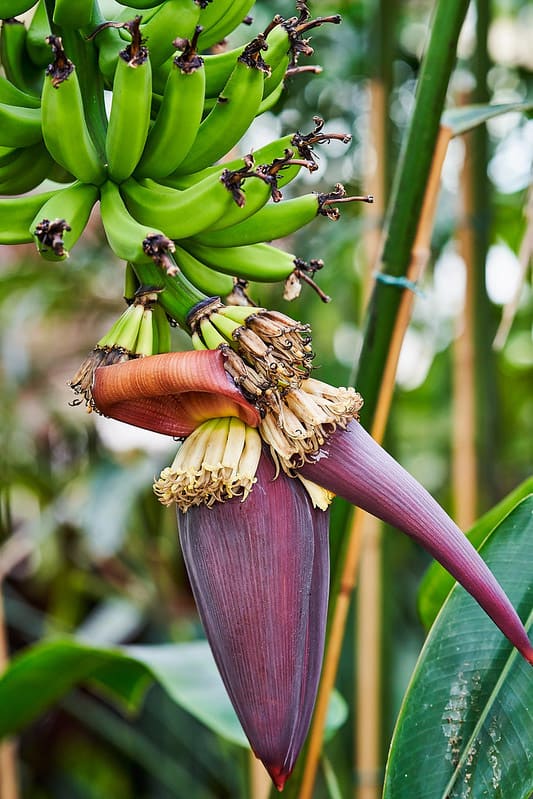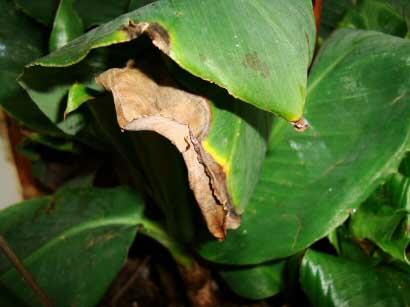Musa, or the Banana is one of the world's most well-known fruits. As well as being delicious and nutritious some varieties can be grown easily as houseplants.
It might seem an unlikely houseplant but actually, it's been grown indoors since the Victorian times, where they were proudly displayed in their humid, warm and sunny conservatories.
Of course, the Victorian conservatories were a little different (and significantly bigger) than the ones we have today, however the basic principle is similar.
The indoor Banana Plant is a wonderful tropical plant and with enough bright light will grow to an impressive size.
Often Dwarf Banana plants are found growing in parts of Asia for mass cultivation. They are sometimes treated as herbaceous perennials, grown as tall specimen plants in gardens at the back of borders during the growing seasons to add a touch of the tropics.
However as they need significant protection to get through the Winter months, it's relatively uncommon for them to be grown like this by the average gardener.
It might seem an unlikely houseplant but actually it's been grown indoors since the Victorian times.
Although you might call it a conservatory, sunroom, solarium, or garden room it's essentially the same but on a smaller scale to the Victorian constructions. If you own a Dwarf Cavendish or are curious about buying one, you will already know they're a delight, especially if you treat them right.
Although true Banana plants are far too large for any house, the Dwarf Musa Banana, or Dwarf Cavendish, fits right in and will give you that tropical feel, even as a small plant.
Are they conservatory only plants?
They can of course be grown in other rooms of the house, but a conservatory is an ideal situation, often giving humid, bright and spacious living accommodation, which this plant craves and ultimately needs to do well.
These "Dwarfs" can still easily reach 6ft / 2m, so with this in mind a young new plant will live happily on a window ledge for a few years at most but that's it. Afterward, the space will run out, and you will need somewhere bigger.
They're somewhat fussy when it comes to care and the leaves although massive and quick growing, are incredibly weak and susceptible to damage.
Feeding, copious watering and large containers are necessary and don't even think about keeping them in a cold room over Winter or your Banana Plant will be a mushy mess by Spring.
Banana plant in direct sun - photo by Iacopo Lorenzini
They grow quickly when it's warm, rewarding you with one new leaf every week or so, they look truly stunning and unique all the time, adding a tropical interest to any area.
If allowed to reach its statuesque proportions, it will dominate in a graceful balanced way that very few houseplants can ever match.
Will you get Banana fruit to eat?
It's a possibility, but conditions will have to be exceptional so probably best not to hold your breath.
The genus Musa has several plants to pick from. When buying a Banana plant for use as a houseplant you want to look for the common Musa × paradisiaca 'Dwarf Cavendish', in fact it will probably be the only one you'll be able to find anyway. It will give you the large size aspect, quick growth along with the potential of edible fruit. It will also tolerate being kept indoors all year round.
M. basjoo is great for the garden because it's the most hardy, however its banana's are inedible and the truck becomes fibrous and messy over time which doesn't lend itself well to indoor decor.
M. acuminata 'Dwarf Cavendish' is similar to M. basjoo as it lends itself well as a garden plant In temperate regions. Its size is more compact but again no familiar fruit will be produced in the short term and it doesn't do particularly well if kept indoors all year long.
Finally a Variegated Banana (Musa x paradisiaca 'Ae Ae') is slowly starting to become more popular. It looks so unusual! Check out the photo gallery for a look at it and let me know in the comments if you've come across it in stores!

Hi, I'm Tom!
If you're like me and enjoy the challenge of growing houseplants and getting them to thrive, then Ourhouseplants can help. This website shares my knowledge and years of growing plants and provides (hopefully) helpful advice on properly caring for your indoor plant friends.
The Common Banana really wants good light with at least a few hours of direct sunlight a day. But it will actually accept a range of light conditions from part shade to full sun. Young plants and new leaves may scorch in full Summer sun especially if your watering routine is stingy.
Low light levels won't go down well in the long term as new growth tends to stall if things are too dark and there isnt enough light. Eventually, the existing leaves will get damaged and the plant starts to look tatty. You want it to be continuously growing and producing new foliage.
Two large indoor banana trees growing in the same container in a garden room next to a large window. In conditions like this, it will be a fast-growing plant.
A well established Banana plant will need copious watering during the warmest months of the year and a good deal more than most houseplants during Spring and Autumn / Fall.
This is down to its large leaf surface area which allows a lot of transpiration to take place - a good thing in the dry atmosphere of a centrally heated home.
Water when the top 5cm / 2 inches of compost is dry. They do like moist soil while they're growing, so in a very bright, warm spot you could be doing this as much as every other day during Summer.
In winter significantly cut back on the watering, otherwise you will be encouraging root rot. Rotting at the base of the plant is also very common if temperatures drop and the potting medium is too wet.
An established plant will need copious watering during the warmest months
The leaves might look tough but are actually very delicate and will rip easily if certain conditions are poor. Low humidity is often a contributing factor to leaf damage so moisture retentive pellets in the drip tray could be helpful, along with a regular misting.
However, because they like humid conditions, misting alone likely won't cut it. Here's why.
If you're serious about growing these tropical plants and you keep running into low humidity issues, then you need to get to grips with the issue. Here is my complete humidity guide.
Indoor Banana Plants have large leaves that form very rapidly during the growing season, so much so a brand new leaf every 10 days is quite common. Therefore feeding on a frequent basis is a must to fuel that level of growth.
Feed well every 2 or 3 weeks using either a general liquid garden fertilizer such as Miracle Grow or if you make your own, that should be fine to use also.
You can of course use a feed designed for houseplants too. Do not fertilize when the plant isn't growing or if you don't want to support any new growth, for example if it's already overgrown and further height is undesired.
There isn't really an upper temperature limit found in the home that is damaging. Although heat pockets, or sun traps such as in between windows and curtains should be avoided as they often heat up too rapidly for the plant to adapt.
When it comes to the lowest acceptable temperature this will depend on the variety you're growing. Some Bananas will survive down to freezing, but in our experience of growing the Dwarf Cavendish, it will start to take damage if you put in in an area lower than 10°C (50°F).
One year our entire plant above the soil was lost. Luckily the rhizome lived on and regrew the following Spring. Still, it wasn't ideal as it had to regrow everything it had lost! They come from warm climates, so they really don't like the cold. Try to keep it warm all year round.
The root system is quite vigorous so young plants, also known as "pups", will fill small pots quickly. You'll need to repot them into bigger ones quite frequently, this may be as much as two or three times in the first year. Normal potting compost at this stage is all you need.
Young plants are known as "pups"
As they get older you can reduce the repotting to once a year. Moving to a slightly larger container each time. As Banana Plants are gross feeders it makes sense to enrich the new soil too. You're welcome to use home made compost or even mix in some horse manure or other organic matter like you would for many garden plants.
However if you use home made compost or animal manure it must be well rotted. You will risk serious damage to the roots and rhizome if you don't use fully decomposed material.
Finished compost is dark brown or black with a crumbly-textured that has a rich earthy smell, if you aren't sure, play it safe and stick to normal potting soil.
The Dwarf Cavendish has a suckering tendency, so young "pups" called Offsets, will be produced as the mother plant ages.
Baby Plants or offsets are the main way you can propagate more plants. There are five growing in this photo.
To create new plants, the pups can be carefully cut away from the main plant, trying to keep some of the roots attached, and then potted up immediately. More details can be found on our offsets section in the propagation article.
You can also leave one or two where they are, to fill in gaps and spaces lower down to give that "fuller" look.
When treated well, Banana plants are very fast growers - as much as one huge new leaf every week or so during the growing season is normal.
If you give it a fair bit of space then it really doesn't take a great deal of time before you'll have a huge and full looking plant.
The variety you have and the growing environment you provide will determine the eventual height. Keeping the plant in a container that is too small, not feeding or generally being "cruel" will mean the maximum height will never be achieved (which might be your intention if space is sparse).
Despite being called a Dwarf Banana Tree, an indoor Banana plant can eventually reach around 3m / 10ft in height. In fact, half this size would still be considered generous by most.
Shiny leaves form from a funnel at the top of the plant. After they open they will lose the shine and have a more matte finish after a few weeks. This is a good size for a plant grown indoors.
There are flowers and as you might expect they precede the rare banana fruit. Quite beautiful and unusual in appearance, but at the end of the day they're uncommon indoors.
This is because the plants need good light and a warm home for a long continuous period. Unless you're based in a country near the equator, you'll get four distinctive seasons every year, one of which is always cold. This can scupper the long continuous period of heat (unless you can provide artificial heat of course).
If growing your own edible bananas is your aim, outside of a warm zone, you must provide artificial heat and lighting in Winter. Should you be fortunate enough to "grow your own" the fruits will need around 3 months to ripen, so leave them on the plant until then.
After you're done with them.... you could make your own Banana Water out of the peels!
It's rare for indoor Banana plants to flower indoors like this. Photo by Geoff McKay
The banana plant has a lot of great qualities and one of them is that it's non-toxic to common pets such as cats and dogs and does not harm people if eaten.
However the leaves are easily ripped and damaged so try to discourage playful pets or children from interacting with them.
The leaves are delicate so if you wash them be careful and avoid leafshine products. All bananas will enjoy being outside in the warmest months of the year, so if you can Summer them outdoors in a sheltered corner from harsh or strong winds they will thank you for it.
No Growth.
Pot bound, unfertilized and low temperatures will slow or completely stop growth. These plants need root space, food and warmth to grow.
Rotting.
As long as you have good drainage, overwatering is actually quite difficult to achieve. But if you are watering too much, have a very heavy, compacted potting medium or the temperature is cold you will increase the probability of rot drastically.
Although they like a rich potting medium (or regular feeding), make sure the container you're using has drainage holes. Let the top few inches of the potting medium dry out before you reach for the watering can again.
Unprotected plants will also succumb in near frost like conditions. This means unheated greenhouses or conservatories could be a big gamble if you have a harsh cold Winter. I've lost plants doing this, so do be careful.
Leaves have yellow or brown edges / tips.
It's almost like the Banana plant expects its leaves to be damaged, so it spends its days churning out new ones so quickly the plant doesn't spend any time making them tougher!
It's normal for leaves to become blemished and ripped from general knocking or even low humidity levels.
Indoor spaces with a lot of footfall can increase damage like this.
Immaculate leaves over a long period are rare, however you can reduce the blemishes by keeping the plant in a protected spot away from children, pets and strong draughts. Keep the humidity high and water well.
Powdery Mildew.
This is fairly common on plants that are put outdoors during the summer months. It shows up as a white, dusty coating that spreads over the upper surface of the leaves. Poor air circulation mixed with excessive high humidity can trigger this. Keep your plants somewhere with air movement to help prevent it.
Treatment is by use of a fungicide. You could give Neem Oil a go for mild cases, otherwise a light dusting of sulfur can help. If these things are too messy, or the problem is quite extensive, you can use a chemical fungicides.
Plant has purple blotches on the leaves.
This is the tell tale sign you have a true Dwarf Cavendish. Young plants will have these blotches although as they mature they will often disappear.
No banana fruits.
Getting them is a challenge, have a read of the "flower" section to find out more.
Fluid on the leaves.
Guttation is the most likely reason - after the plant has been watered well, in the morning it's common to find water droplets have collected at the leaf tips. Perfectly normal and harmless, the drops will either drip on to the floor or evaporate during the day.
If this happens all the time, it might be a sign you're giving too much water. Cut back a little.
A more sinister cause might be down to pests, in particular those which secrete honeydew such as aphids. Guttation results in simple water droplets, honeydew is sticky so you can tell the difference easily by touching the fluid.
Red Spider Mites.
Keeping the humidity high will deter Red Spider Mite from your indoor banana plant, however if they do strike they can be treated with an insecticide.
(Gallery) Credit for the Variegated Banana photo - Mokkie
